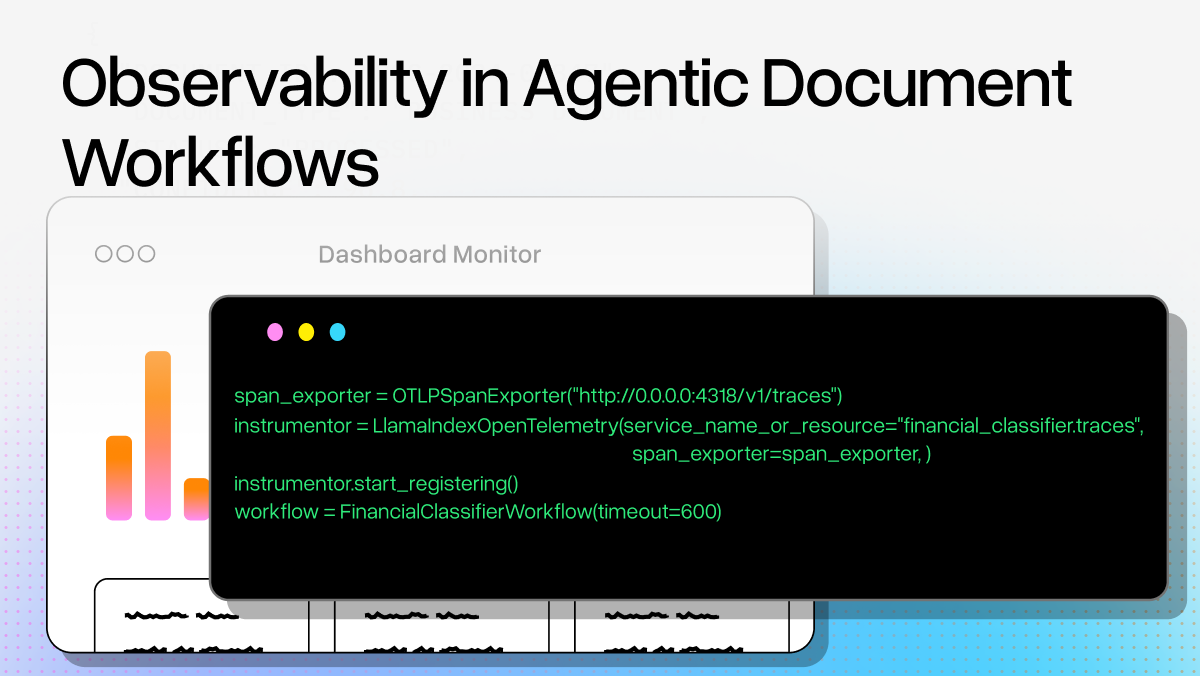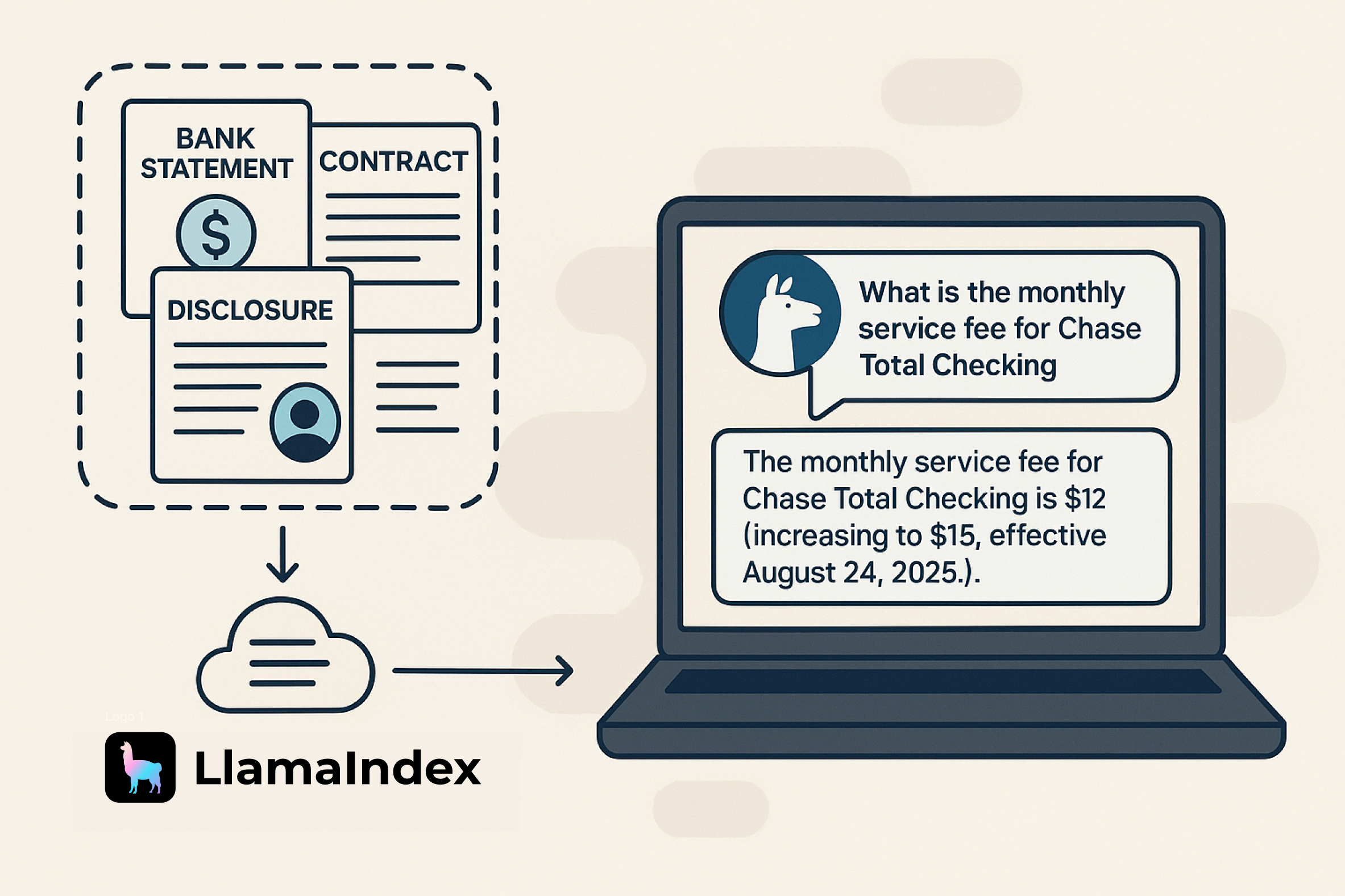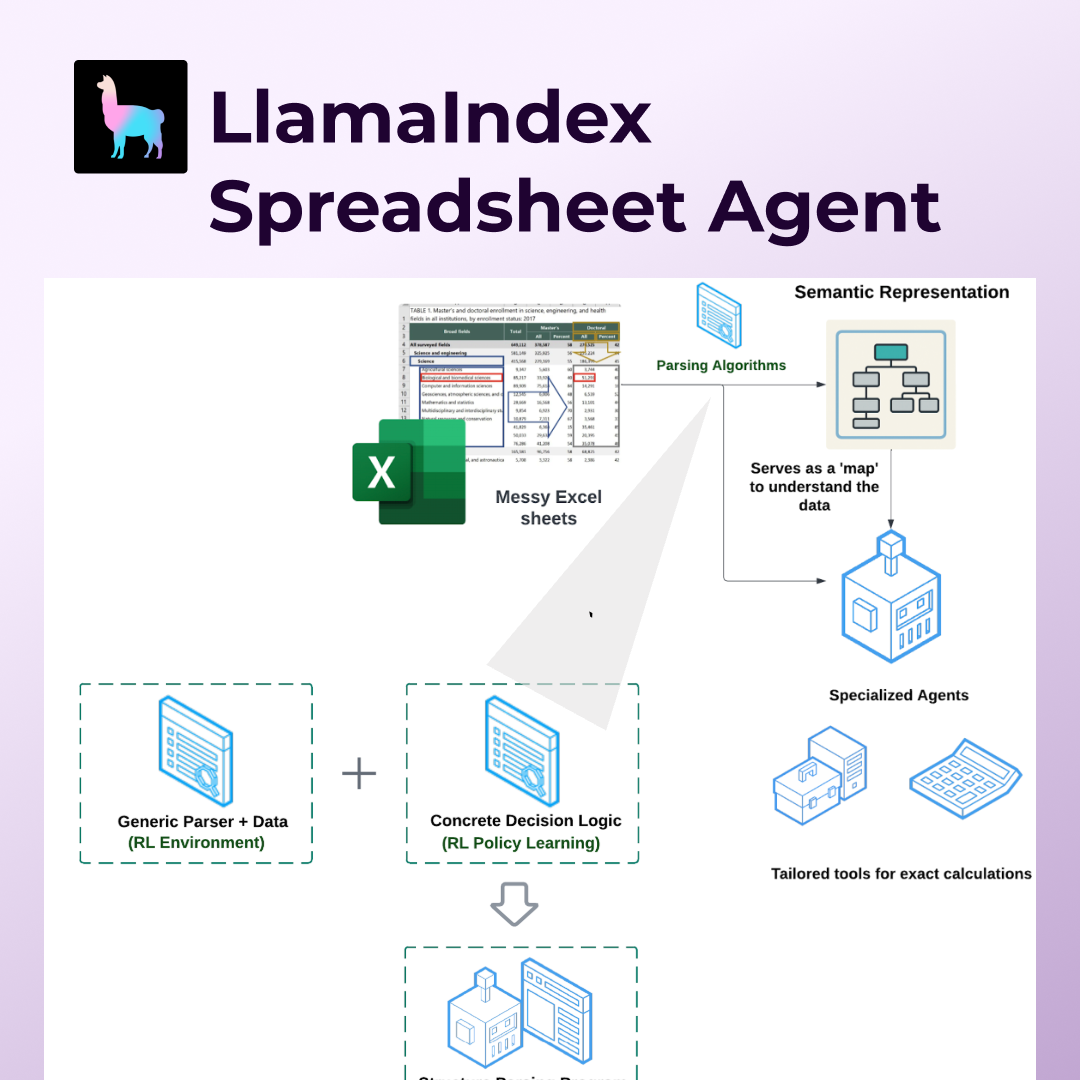The Challenge of Multi-Step Document Processing
Document workflows are at the heart of many business operations: processing invoices, extracting data from financial statements, analyzing contracts, and transforming unstructured PDFs into actionable insights. These workflows often involve multiple steps (such as classification, extraction, validation, and synthesis) each orchestrated by AI agents that need to make decisions based on document content.
Consider a financial document processing pipeline: you receive a PDF that could be an income statement, a balance sheet, or a cashflow statement. Your system needs to:
- Classify the document type
- Extract the relevant structured data based on that classification
- Validate the extracted information
- Route it to the appropriate downstream process
Each of these steps involves AI reasoning over unstructured content, and when something goes wrong, incorrect classification, missed fields, or validation failures, debugging becomes a nightmare without proper visibility.
Why Observability Matters for Document Workflows
This is where observability becomes critical. In document workflows powered by AI agents, you need to understand:
- How unstructured context is transformed into structured output
- Which classification decisions were made and why
- What data was successfully extracted versus what failed
- Where validation or synthesis steps broke down
- The performance characteristics of each step in your pipeline
Unlike traditional software where you might debug with print statements, AI-powered document workflows are complex, multi-step processes with non-deterministic components. In this scenario, observability ceases to be a “nice-to-have”, and becomes essential for understanding system behavior, preventing failures, and improving accuracy over time.
In modern applications, observability should be at the core of the tech stack. It can help with understanding the behavior of systems, prevent or reduce the damage caused by crashes and, overall, help developers improve the UX by getting to know the major pain points of the user flow.
Building Observable Document Workflows with LlamaIndex
We power document workflows with LlamaIndex Agent Workflows, a code-based tool that's perfect for integrating with observability pipelines. Instead of relying on heavy logging with debugging statements lost within hundreds of lines of code, Agent Workflows provide a cleaner and more maintainable way of tracing their own flow, thanks to their built-in observability features that are directly derived from their stepwise and event-driven architecture, in which every step emits and receives events. This structure naturally maps to the OpenTelemetry model of spans and traces, making it straightforward to instrument and monitor your document processing pipelines.
In this blog, we'll walk through building a financial document classification and extraction workflow, showing you how to set up comprehensive observability from the ground up. We'll use only open source technologies: Agent Workflows themselves, OpenTelemetry and Jaeger. By the end, you'll be able to trace every step of your document workflow and even dispatch custom events for fine-grained control over monitoring.
1. Setup
Throughout this example, we will be using uv and Docker: make sure to have them both installed to follow along!
Let's first of all set up our environment by initializing it and installing the needed dependencies:
bash
uv init .
uv add llama-index-workflows \
llama-cloud-services \
llama-index-observability-otel \
opentelemetry-exporter-otlp-proto-http
uv tool install llamactl # this will be helpful later!
source .venv/bin/activate # or .venv\Scripts\activate if you are on Windows Now let's configure Jaeger for tracing in a compose.yaml file…
yaml
# compose.yaml
name: jaeger-tracing
services:
jaeger:
image: jaegertracing/all-in-one:latest
ports:
- 16686:16686
- 4317:4317
- 4318:4318
- 9411:9411
environment:
- COLLECTOR_ZIPKIN_HOST_PORT=:9411…And deploy it locally through Docker Compose:
bash
docker compose up -d # the service is now running in the backgroundFinally, let's create the directory structure to develop and serve our workflow:
bash
mkdir -p src/financial_classifier/
touch src/financial_classifier/__init__.pyWith all this being set, we can now move on to defining our workflow.
2. The workflow
For our financial document processing use case, we'll build a workflow that leverages two LlamaCloud products: LlamaExtract and LlamaClassify. This workflow will automatically classify financial documents and extract structured data based on the document type: exactly the kind of multi-step pipeline that benefits from comprehensive observability.
Let's setup our LlamaCloud services as resources for the workflow, and save this file in src/financial_classifier/resources.py :
python
import os
from pydantic import BaseModel, Field
from llama_cloud_services import LlamaExtract
from llama_cloud_services.beta.classifier import ClassifyClient
class IncomeStatement(BaseModel):
"""Financial performance over a period"""
period_end: str = Field(description="End date of reporting period")
revenue: float = Field(description="Total income from sales/services")
expenses: float = Field(description="Total costs incurred")
net_income: float = Field(description="Profit or loss (revenue - expenses)")
currency: str | None = Field(default=None, description="Currency code")
class CashflowStatement(BaseModel):
"""Cash movement over a period"""
period_end: str = Field(description="End date of reporting period")
operating_cashflow: float = Field(description="Cash from core business operations")
investing_cashflow: float = Field(description="Cash from investments/asset purchases")
financing_cashflow: float = Field(description="Cash from debt/equity activities")
net_change: float = Field(description="Total change in cash position")
class BalanceSheet(BaseModel):
"""Financial position at a point in time"""
report_date: str = Field(description="Snapshot date")
total_assets: float = Field(description="Everything the company owns")
total_liabilities: float = Field(description="Everything the company owes")
equity: float = Field(description="Owner's stake (assets - liabilities)")
currency: str | None = Field(default=None, description="Currency code")
async def get_llama_extract(*args, **kwargs) -> LlamaExtract:
return LlamaExtract(api_key=os.getenv("LLAMA_CLOUD_API_KEY"))
async def get_llama_classify(*args, **kwargs) -> ClassifyClient:
return ClassifyClient.from_api_key(api_key=os.getenv("LLAMA_CLOUD_API_KEY", ""))
We can now define the events for the workflow, and save them under src/financial_classifier/events.py :
python
from workflows.events import StartEvent, StopEvent, Event
from typing import Literal
from pydantic import ConfigDict
from .resources import CashflowStatement, IncomeStatement, BalanceSheet
class InputDocumentEvent(StartEvent):
path: str
class ProgressEvent(Event): # used to monitor progress
message: str
class ClassificationEvent(Event):
classification: Literal["income_statement", "cashflow_statement", "balance_sheet"]
reasons: str
class ExtractedDataEvent(StopEvent):
extracted_data: CashflowStatement | IncomeStatement | BalanceSheet | None
error: str | None = None
model_config = ConfigDict(arbitrary_types_allowed=True) Once we have resources and events, we can structure the financial classification workflow and save it as src/financial_classifier/workflow.py :
python
from workflows import Workflow, step, Context
from workflows.resource import Resource
from typing import Annotated
from llama_cloud_services.beta.classifier import ClassifyClient
from llama_cloud_services.extract import LlamaExtract, ExtractConfig
from llama_cloud.types.classifier_rule import ClassifierRule
from .events import InputDocumentEvent, ClassificationEvent, ExtractedDataEvent, ProgressEvent
from .resources import get_llama_classify, get_llama_extract, BalanceSheet, IncomeStatement, CashflowStatement
class FinancialClassifierWorkflow(Workflow):
@step
async def classify_input_file(self, ev: InputDocumentEvent, classifier: Annotated[ClassifyClient, Resource(get_llama_classify)], ctx: Context) -> ClassificationEvent | ExtractedDataEvent:
ctx.write_event_to_stream(ProgressEvent(message=f"Classifying {ev.path}..."))
async with ctx.store.edit_state() as state:
state.input_file_path = ev.path
rules = [ClassifierRule(type="income_statement", description="Shows revenue, expenses, and profit/loss over a period"), ClassifierRule(type="cashflow_statement", description="Tracks cash movements across operating, investing, and financing activities"), ClassifierRule(type="balance_sheet", description="Lists assets, liabilities, and equity at a specific date")]
result = await classifier.aclassify(rules=rules, files=ev.path)
classification_result = result.items[0].result
if classification_result is not None and classification_result.type is not None:
return ClassificationEvent(
classification=classification_result.type, # type: ignore
reasons=classification_result.reasoning,
)
else:
return ExtractedDataEvent(extracted_data=None, error="Failed to produce a classification for the input file")
@step
async def extract_details_from_file(self, ev: ClassificationEvent, extractor: Annotated[LlamaExtract, Resource(get_llama_extract)], , ctx: Context) -> ExtractedDataEvent:
ctx.write_event_to_stream(ProgressEvent(message=f"File classified as {ev.classification} because of the following reasons: {ev.reasons}"))
ctx.write_event_to_stream(ProgressEvent(message="Extracting details..."))
if ev.classification == "balance_sheet":
data_model = BalanceSheet
elif ev.classification == "cashflow_statement":
data_model = CashflowStatement
else:
data_model = IncomeStatement
state = await ctx.store.get_state()
result = await extractor.aextract(data_schema=data_model, config=ExtractConfig(), files=state.input_file_path)
if result.data is not None:
data = data_model.model_validate(result.data)
ctx.write_event_to_stream(ProgressEvent(message=f"Extracted the following data:\n{data.model_dump_json(indent=4)}"))
return ExtractedDataEvent(extracted_data=data)
else:
return ExtractedDataEvent(
extracted_data=None,
error="It was not possible to extract the data from the provided input file"
)
workflow = FinancialClassifierWorkflow(timeout=600) In order to serve our workflow locally, we can use llamactl (which we installed in the setup), we need to modify our pyproject.toml to match this structure:
toml
[build-system]
requires = ["hatchling"]
build-backend = "hatchling.build"
[project]
name = "financial-classifier"
version = "0.1.0"
description = "Add your description here"
readme = "README.md"
requires-python = ">=3.13"
dependencies = [
"llama-cloud-services>=0.6.79",
"llama-index-observability-otel>=0.2.1",
"llama-index-workflows>=2.11.1",
"opentelemetry-exporter-otlp-proto-http>=1.38.0",
]
[tool.hatch.build.targets.wheel]
only-include = ["src/financial_classifier"]
[tool.hatch.build.targets.wheel.sources]
"src" = ""
[tool.llamadeploy.workflows]
classify-and-extract = "financial_classifier.workflow:workflow"
[tool.llamadeploy]
name = "financial-classifier"
env_files = [".env"]
llama_cloud = true We will now have a financial-classifier service that we can deploy locally with llamactl serve , and that includes our financial classification workflow under the classify-and-extract namespace.
3. Observability
Now that we have our document workflow set up, we can plug in its observability layer to track how our unstructured PDFs are transformed into structured financial data. By integrating with OpenTelemetry, we'll be able to see exactly where classification happens, how long extraction takes, and where any failures occur in our pipeline.
To enable this, we need to add this code within src/financial_classifier/instrumentation.py :
python
from llama_index.observability.otel import LlamaIndexOpenTelemetry
from opentelemetry.exporter.otlp.proto.http.trace_exporter import (
OTLPSpanExporter,
)
span_exporter = OTLPSpanExporter("http://0.0.0.0:4318/v1/traces")
instrumentor = LlamaIndexOpenTelemetry(
service_name_or_resource="financial_classifier.traces",
span_exporter=span_exporter,
) And then you should add this to of your workflow.py script:
python
from .instrumentation import instrumentor
## rest of the code here
instrumentor.start_registering()
workflow = FinancialClassifierWorkflow(timeout=600)As you can see, in six lines of code we have set up the entire observability engine!
4. Running and Inspecting Traces
Now that everything is ready, serve the workflow locally with llamactl :
bash
llamactl serve --port 8000We can then download a sample income statement to run the workflow with:
bash
curl -L https://www.republicguyana.com/pdfs/commercial-account/SAMPLE-INCOME-STATEMENT.pdf -o financial_document.pdf Now we can run the workflow from the server we created with the following code (saved in scripts/run_workflow.py ):
python
import asyncio
import httpx
from financial_classifier.events import InputDocumentEvent, ProgressEvent
from workflows.client import WorkflowClient
async def run_workflow():
httpx_client = httpx.AsyncClient(base_url="http://127.0.0.1:8000/deployments/financial-classifier")
wf_client = WorkflowClient(httpx_client=httpx_client)
data = await wf_client.run_workflow_nowait(workflow_name="classify-and-extract", start_event=InputDocumentEvent(path="financial_document.pdf"))
async for event in wf_client.get_workflow_events(data.handler_id):
ev = event.load_event()
if isinstance(ev, ProgressEvent):
print(ev.message)
result = None
while result is None:
handler_data = await wf_client.get_result(data.handler_id)
result = handler_data.result
await asyncio.sleep(0.1)
print(f"Final result:\n{result}")
if __name__ == "__main__":
asyncio.run(run_workflow()) After you run this script with uv run scripts/run_workflow.py , you can head over to the Jeager UI (http://localhost:16686 ) and select the financial_classifier.traces service. You will see one trace with five collected spans and, if you open it, you will see something similar to this image:

Congratulations: you just successfully instrumented and traced your first document workflow! You can now see the complete journey of your financial document through classification and extraction, with timing information for each step.
5. Creating Custom Event Traces
Beyond the built-in observability, you can gain even more fine-grained control over what you monitor in your document workflows. For instance, you might want to track classification confidence scores, extraction metadata, or validation results (specific metrics that matter for your document processing use case).
In order to create custom events, we need to subclass BaseEvent from the llama-index-instrumentation package, and we can do so by adding the following code to our instrumentation.py script:
python
# rest of the code
from llama_index_instrumentation import get_dispatcher
from llama_index_instrumentation.base.event import BaseEvent
dispatcher = get_dispatcher()
class ClassificationMetadata(BaseEvent):
duration: float
metadata: dict[str, Any]
@classmethod
def class_name(cls) -> str:
return "ClassificationMetadata"
class ExtractionMetadata(BaseEvent):
duration: float
metadata: dict[str, Any]
@classmethod
def class_name(cls) -> str:
return "ExtractionMetadata"
# rest of the code
instrumentor = LlamaIndexOpenTelemetry(
service_name_or_resource="financial_classifier.custom_traces", # modify the service name here to make it easier to distinguish from the previous run
span_exporter=span_exporter,
) Now, within our workflow, we can use the dispatcher.event() method to collect an event with OpenTelemetry and export it to Jaeger. We can do so by modifying the two steps of our workflow:
python
# rest of the code
from .instrumentation import instrumentor, ExtractionMetadata, ClassificationMetadata, dispatcher
class FinancialClassifierWorkflow(Workflow):
@step
async def classify_input_file(self, ev: InputDocumentEvent, classifier: Annotated[ClassifyClient, Resource(get_llama_classify)], ctx: Context) -> ClassificationEvent | ExtractedDataEvent:
# ...
start = time.time()
result = await classifier.aclassify(rules=rules, files=ev.path)
classification_result = result.items[0].result
if classification_result is not None and classification_result.type is not None:
dispatcher.event(event=ClassificationMetadata(duration=time.time()-start, metadata={"confidence": classification_result.confidence})) # add this line to send the custom event
# ...
@step
async def extract_details_from_file(self, ev: ClassificationEvent, extractor: Annotated[LlamaExtract, Resource(get_llama_extract)], ctx: Context) -> ExtractedDataEvent:
# ...
state = await ctx.store.get_state()
start = time.time()
result = await extractor.aextract(data_schema=data_model, config=ExtractConfig(), files=state.input_file_path)
if result.data is not None:
dispatcher.event(event=ExtractionMetadata(duration=time.time()-start, metadata=result.extraction_metadata or {})) # add this line to send the custom event
# ...
instrumentor.start_registering()
workflow = FinancialClassifierWorkflow(timeout=600) Now let's re-run the workflow (using the same run_workflow.py script) and take a look at the traces again:

As you can see from the Jaeger UI, our custom events where successfully emitted, registered and exported! This level of detail is crucial for understanding not just that your document workflow ran, but how well it performed.
Wrapping Up
To sum things up, in this blog post we:
- Started with the real-world challenge of multi-step document workflows like financial extraction and invoice processing
- Explained why observability is critical for understanding how unstructured documents are transformed into structured, actionable data
- Built a complete financial document classification and extraction workflow using LlamaIndex Agent Workflows
- Configured comprehensive observability using LlamaIndex's first-party integration with OpenTelemetry
- Served the workflow locally with
llamactl, ran it, and collected detailed traces in Jaeger - Added custom events to track document-specific metrics like classification confidence and extraction metadata
You can find all the code for this blog in this repository on GitHub and you can learn more about observability in the dedicated documentation.





